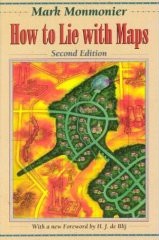Review: How to Lie with Maps
How to Lie with Maps (Second Edition)
by Mark Monmonier
University of Chicago Press, 1996. Softcover, 220 pp. ISBN 0-226-53421-9
 While reading this modern classic by Syracuse University geography professor Mark Monmonier (see previous entry), I was struck by how much common ground this book shares with the recent Making Maps by John Krygier and Denis Wood (reviewed here). Both books are about mapmaking choices, but where Krygier and Wood are fundamentally prescriptive — don’t do that; this is better — Monmonier is not only prescriptive but cautionary. Where Monmonier prescribes, it’s in the context of what the mapmaker intends: i.e., if you’re trying to present a point of view (or fool the public), here are some of the ways to do it. As a corollary, he is cautionary: watch out for maps that do this. How to Lie with Maps is as much a warning for map readers as much as mapmakers, the user as much as the designer.
While reading this modern classic by Syracuse University geography professor Mark Monmonier (see previous entry), I was struck by how much common ground this book shares with the recent Making Maps by John Krygier and Denis Wood (reviewed here). Both books are about mapmaking choices, but where Krygier and Wood are fundamentally prescriptive — don’t do that; this is better — Monmonier is not only prescriptive but cautionary. Where Monmonier prescribes, it’s in the context of what the mapmaker intends: i.e., if you’re trying to present a point of view (or fool the public), here are some of the ways to do it. As a corollary, he is cautionary: watch out for maps that do this. How to Lie with Maps is as much a warning for map readers as much as mapmakers, the user as much as the designer.
All maps deceive, says Monmonier, because they must be selective in the information they present: projections distorts, angles or shapes; maps at small scale leave out detail included in large-scale maps; lines must be displaced, smoothed or simplified and area features simplified for readability’s sake. But, he writes, “[b]ecause most map users willingly tolerate white lies on maps, it’s not difficult for maps also to tell more serious lies” (p. 1). The reason for this is that maps have a dual purpose: not only to inform their audience, but also to impress them — to persuade, to make a point, to sell a product. It may be as straightforward as advertising suggesting that your store is in a convenient location, or that your rail line is more direct than it actually is. But it can also be as subtle as your choice of colour or shading; Monmonier spends quite a bit of time on choropleth maps and the impact of different class breaks. And it can be insidious: maps’ normative function makes countries assert disputed territorial claims (Kashmir, Argentine Antarctica) on postage stamps; maps deliberately in error to conceal secrets or fool the enemy; non-existent “trap streets” to catch plagiarism among your cartographic competitors (see previous entry).
Monmonier even provides eleven rules for developers trying to convince the town planning board (e.g., rule eight: “Distract with aerial photographs and historical maps”) — intelligence that can be used as much by the developers’ opponents and the planning board as the developers themselves. The point of the book is to raise awareness of these sorts of cartographic tricks, whether they’re used for good or for ill; the end result is an improvement in cartographic literacy. This puts How to Lie with Maps in the same league as Darrell Huff’s How to Lie with Statistics (no doubt the inspiration for Monmonier’s title), E. H. Carr’s What Is History? or any similar text on media and public relations. In other words, essential reading, if not a civic duty for an educated public essential to a democracy.
More on my book review policy.
- Buy How to Lie with Maps at Amazon.com

Comments
blog comments powered by Disqus